The Latin America, Middle East and Africa Rat Model Market would witness market growth of 13.9% CAGR during the forecast period (2022-2028).
Laboratory rats are brown rats of the subspecies Rattus norvegicus Domestic that are bred and kept for scientific purposes. Due to their physical, physiological, and genetic resemblance to humans, mice and rats have long been utilized as animal models for scientific study. The benefits of rats include their tiny size, ease of care, short lifespan, and plentiful genetic resources.
Establishing proper animal models of disease is crucial to fundamental medical research, and rats and mice are the animals of choice for this purpose. Due to their small size, low operational costs, generally stable embryonic cells, and adaptability to many genetic modifications and gene editing, mice have long been the most useful model animal for evaluating human gene functions.
In addition, even when the human gene underlying a disease had been found without the use of a rat model, mutant rat strains (in specific KO strains) were developed to study the gene's function and the pathogenesis of the disease. Over 350 rat genes have been discovered as underlying diseases or as playing a vital part in crucial biological processes that are changed in disease, providing a rich reservoir of disease models.
The pharmaceutical industry in regional countries is growing at an exponential rate. The pharmaceutical market in South Africa continues to be the largest in all of Sub-Saharan Africa. According to the International Trade Administration, the total expenditure on pharmaceuticals was anticipated to reach $4.1 billion in 2019, and $3.6 billion in 2020, according to estimates. Due to the fact that the pharmaceutical sector of the country requires more efforts in order to be strengthened, the adoption of the rat model is anticipated to increase and this factor is boosting the growth of the regional rat model market.
The Brazil market dominated the LAMEA Rat Model Market by Country in 2021; thereby, achieving a market value of $35 million by 2028. The Argentina market is showcasing a CAGR of 14.5% during (2022 - 2028). Additionally, The UAE market would register a CAGR of 13.6% during (2022 - 2028).
Based on Technology, the market is segmented into CRISPR/CAS & Others, Nuclear transferase, and Embryonic Stem Cell & Microinjection. Based on Type, the market is segmented into Outbred, Hybrid, Knockout, Inbred, Immunodeficient, and Conditioned. Based on Service, the market is segmented into Breeding, Genetic testing, Cryopreservation, Re-derivation, and Quarantine Depending & Others. Based on Application, the market is segmented into Toxicology, Oncology, Immunology, and Neurology & Others. Based on End-use, the market is segmented into CROs, Pharmaceutical & Biotechnology Companies, and Academic & Research Institutes. Based on countries, the market is segmented into Brazil, Argentina, UAE, Saudi Arabia, South Africa, Nigeria, and Rest of LAMEA.
Free Valuable Insights: The Global Rat Model Market is Predict to reach $1.7 Billion by 2028, at a CAGR of 7.4%
The market research report covers the analysis of key stake holders of the market. Key companies profiled in the report include Charles River Laboratories International, Inc., Laboratory Corporation of America Holdings, Inotiv, Inc., genOway, Janvier Labs, Taconic Biosciences, Inc. (H.I.G. Capital), TransViragen, Inc., Biomedical Research Models, Inc. (Biomere) and Cyagen Biosciences.
By Technology
By Type
By Service
By Application
By End-use
By Country
Our team of dedicated experts can provide you with attractive expansion opportunities for your business.

